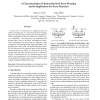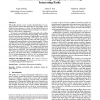34 search results - page 2 / 7 » Characterizing the d-TLB behavior of SPEC CPU2000 benchmarks |
EUROPAR
2008
Springer
13 years 6 months ago
2008
Springer
Abstract. Understanding program behavior is at the foundation of program optimization. Techniques for automatic recognition of program constructs characterize the behavior of code ...
DSN
2008
IEEE
13 years 11 months ago
2008
IEEE
In this work, we characterize a significant source of software derating that we call instruction-level derating. Instruction-level derating encompasses the mechanisms by which co...
ICCD
2008
IEEE
14 years 2 months ago
2008
IEEE
— Increasing sizes of benchmarks make detailed simulation an extremely time consuming process. Statistical techniques such as the SimPoint methodology have been proposed in order...
ISPASS
2005
IEEE
13 years 10 months ago
2005
IEEE
Performance evaluation using only a subset of programs from a benchmark suite is commonplace in computer architecture research. This is especially true during early design space e...
POPL
2007
ACM
14 years 5 months ago
2007
ACM
Path profiles provide a more accurate characterization of a program's dynamic behavior than basic block or edge profiles, but are relatively more expensive to collect. This h...


